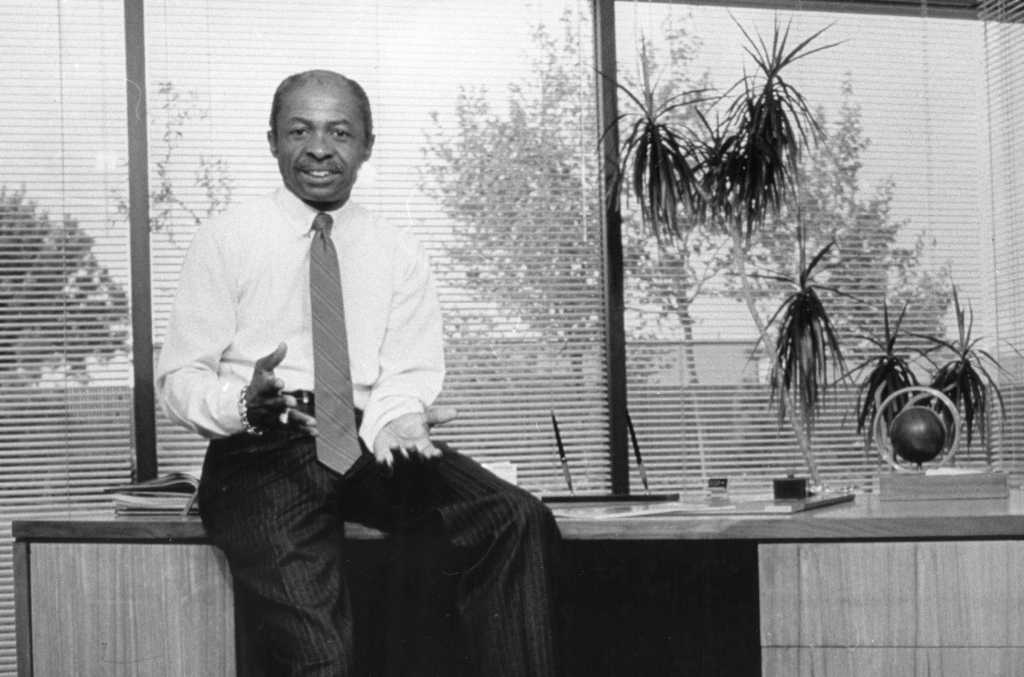Bell also co-founded what is now the Computer History Museum of Mountain View, California; established the ACM Gordon Bell Prize to honor innovations in high-performance computing; and was granted the National Medal of Technology and Innovation in 1991. He died at 89 from pneumonia.
Lynn Conway: Breaking down barriers
January 2, 1938 – June 9, 2024
While working at IBM on the Advanced Computing Systems project in the 1960s, Lynn Conway developed dynamic instruction scheduling (DIS), a computing architecture technique that enabled computers to perform multiple operations simultaneously, paving the way for the first superscalar computer.
Conway’s reward: she was fired from IBM and all record of her work expunged — all because she’d come out to her employer as being transgender. With her career erased, Conway underwent gender-affirming surgery and began a new career under a new name.
Despite the professional setback, Conway continued building a legacy of profound innovations. In 1973, while working at Xerox PARC with Carver Mead and Bert Sutherland, she co-developed very large-scale integration (VLSI), enabling microchips to hold millions of circuits — kicking off a revolution in computer architecture and design. She returned to MIT, a school she’d previously dropped out of in the 1950s after a physician threatened her with institutionalization, to teach the university’s first VLSI design course.
Related reading: Unsung innovators: Lynn Conway and Carver Mead
Conway then worked at DARPA before joining the faculty of the University of Michigan, where she remained for 13 years until her retirement in 1998. She did not come out about her work at IBM until 2000, after which she became an outspoken advocate for transgender rights. Conway was heartened by the changing landscape compared to when she grew up, saying: “Parents who have transgender children are discovering that if they… let that person blossom into who they need to be, they often see just remarkable flourishing of a life force.”
In 2020, fifty-two years after Conway was fired, IBM issued a formal apology.
She passed away at the age of 86 from a heart condition.
Trygve Reenskaug: A model for success
June 21, 1930 – June 14, 2024
When Xerox PARC developed the Alto computer in 1973, it debuted a new paradigm: the graphical user interface (GUI), an abstraction between the user and the computer’s underlying data. To develop GUI programs, developers also needed a new model to work with.
University of Oslo computer science professor Trygve Reenskaug was visiting PARC in 1979 when he came up with the solution: the model-view-controller (MVC) pattern. Originally designed in Smalltalk, an object-oriented language that was developed at PARC from 1972 to 1980, MVC eventually became popular for developing web applications, including in Ruby on Rails.
MVC wasn’t Reenskaug’s only innovation: in 1963, he developed an early CAD program, Autokon, which was widely used in maritime and offshore industries. And in 1986, he founded software company Taskon, where he developed the software package OOram (Object-Oriented role analysis and modeling). OOram later evolved into data, content, and interaction (DCI), a software development model that continues to be used to this day, such as in Tinder’s mobile app.
Reenskaug remained humble about his contributions, writing, “I have sometimes been given more credit than is my due.” He cited teammates Alan Kay, Jim Althoff, Per Wold, and Odd Arild Lehne, among others, who carried the baton before and after him.
Reenskaug was 93 when he died.
Bruce Bastian: Perfecting the word
March 23, 1948 – June 16, 2024
In 1979, while earning his master’s degree in computer science at Brigham Young University, Bruce Bastian partnered with his professor, Alan Ashton, to co-found Satellite Software International. Their flagship product was word processing software that they had co-developed for the city of Orem, Utah. That program later became the new name of their company: WordPerfect Corporation.
The WordPerfect software debuted several innovations, including function-key shortcuts, numbering of lines in legal documents, and a scripting capability. It went toe-to-toe with Microsoft Word, trouncing it in the MS-DOS era but proving slow to catch up in Windows, where Microsoft bundled Word in its Office suite. But over the years, versions of WordPerfect also proliferated for Atari, Amiga, Unix, Linux, Macintosh, and iOS devices.
WordPerfect was acquired by Novell in 1994 and by Corel, now Alludo, in 1996. Only the Windows version is still supported, having been most recently updated in 2021; it remains popular, especially among lawyers.
Bastian left the Mormon church in the 1980s when he came out as gay. He became a staunch advocate for LGBTQIA+ rights, sitting on the board of the nonprofit Human Rights Campaign and donating $1 million to defeat California’s Proposition 8 to outlaw same-sex marriage in 2008. His own nonprofit, the B.W. Bastian Foundation, continues to support organizations that further human rights and the LGBTQIA+ community.
“I’m doing this for the kid in Idaho, growing up on a farm. I don’t want him to go through the s— I went through,” Bastian told the Salt Lake Tribune.
Bastian died at 76 from complications associated with pulmonary fibrosis.
Lubomyr Romankiw: Magnetic personality
April 17, 1931 – June 27, 2024
Born in Zhovkva, Ukraine (then part of Poland), Romankiw emigrated to Canada, where he attained citizenship and earned his bachelor’s degree in chemical engineering. After earning a master’s and Ph.D. in metallurgy and materials in 1962 from MIT, he joined IBM.
At that time, IBM’s mainframes relied on drum storage for memory, which was slow, heavy, expensive, and limited to a few hundred kilobytes. In the 1970s, Romankiw partnered with co-worker David Thompson to invent magnetic thin film storage heads. The innovation spanned almost a dozen patents that reduced the size and increased the density of data storage devices. Any modern device that uses magnetic-head hard drives (as opposed to solid-state drives) still employs Romankiw’s innovations. His work earned him a place in the National Inventors Hall of Fame in 2012.
Romankiw spent his entire career at IBM, earning the rank of IBM Fellow in 1986. He also became a Fellow of the Electrochemical Society in 1990. Among Romankiw’s other developments and 65 patents were inductive power converters and inductors for high-efficiency solar cells.
He was 93 when he passed.
Susan Wojcicki: Channeling innovation
July 5, 1968 – August 9, 2024
When Larry Page and Sergey Brin founded Google in 1998, they needed office space. Management consultant Susan Wojcicki provided her garage — and, over the years, so much more.
Hired as Google employee #16, Wojcicki went on to play several defining roles in the company: she was Google’s first marketing manager in 1999; she product-managed the launch of Google Image Search in 2001; she was AdSense’s first product manager in 2003; and, while heading the nascent Google Video division, she initiated and managed Google’s acquisition of competitor YouTube in 2006.
In 2014, Wojcicki was appointed CEO of YouTube. Over the next nine years, she oversaw the service’s expansion into multiple countries, languages, and brands, including YouTube Premium, TV, Shorts, Music, and Gaming. The platform’s annual advertising revenue now exceeds $50 billion.
Throughout her career, Wojcicki’s work embodied the early days of Google, which she defined as “incredible product and technology innovation, huge opportunities, and a healthy disregard for the impossible.” She stepped down as YouTube CEO in February 2023, remaining in an advisory role at parent company Alphabet. She passed away 18 months later at age 56 from lung cancer.
Roy L. Clay Sr.: Godfather of Silicon Valley
August 22, 1929 – September 22, 2024

Roy L. Clay Sr.
Palo Alto Historical Association
Roy Clay was one of nine children raised in a household without electricity or a toilet. He nonetheless grew up to become the one of the first Black Americans to graduate from St. Louis University, earning his degree in mathematics.
After being denied a job interview at McDonnell Aircraft Manufacturing on account of his skin color, Clay persisted in applying until he finally got a job. He worked at McDonnell as a computer programmer for two years, then joined Lawrence Livermore National Laboratory, where he wrote software to monitor an atomic explosion’s radiation diffusion. The reputation he developed there as a talented software developer landed him a job at Hewlett-Packard.
At HP, Clay wrote software for and led the development of the company’s first minicomputer, the 2116A, released in 1966. The computer and its immediate successors sold exceptionally well for decades, helping cement HP’s leadership in the early computer industry. Rising through the ranks at HP, Clay helped expand its talent pool by hiring engineers from historically Black colleges and universities (HBCUs).
Clay left HP in 1971 to start a consulting firm that advised the likes of Kleiner Perkins Caufield & Byers, a leading venture capital firm that helped shape Silicon Valley. In 1977, he formed his own company, ROD-L Electronics, a manufacturer of electrical safety test equipment. ROD-L hired a diverse workforce and offered employees a flex-time schedule as well as full tuition reimbursement. Said Clay, “If you’re not bothering to learn more, then you’re becoming unproductive.”
Clay was a pioneer not just in IT, but in politics: he was the first Black council member for the city of Palo Alto, California (1973–1979) and was elected to the position of city vice mayor (1976–1977).
As a trailblazer who worked tirelessly to diversify the tech industry, he earned the nickname “Godfather of Silicon Valley” — an honorific he adopted for his 2022 self-published memoir, Unstoppable: The Unlikely Story of a Silicon Valley Godfather.
Clay passed away at 95.
Ward Christensen: Modem maverick
October 23, 1945 – October 11, 2024
Ward Christensen spent his entire 44-year career as a systems engineer at IBM — but it was his hobbies that earned him a place in history.
In 1977, when Christensen needed to convert a CP/M floppy disk to an audio cassette, he developed a transfer protocol consisting of 128-byte blocks, the sector size used by CP/M floppies. The protocol proved so versatile and reliable for a variety of platforms that it evolved into XMODEM, which became a standard for transferring data files across dial-up modem connections, especially at slower speeds such as 300 baud.
Christensen’s work on XMODEM earned him a sponsorship from the White Sands Missile Range to dial into the ARPANET. But he was frustrated by the organization’s design-by-committee approach, where ideas languished. When Chicago’s Great Blizzard of 1978 left Christensen and his fellow computing enthusiasts stranded in their homes, Christensen called his friend Randy Suess to develop a way for their local hobby computer club to meet virtually. The two collaborated, with Suess providing the hardware and Christensen the software. Within two weeks, the Computerized Bulletin Board System (CBBS) was up and running.
CBBS became the first of tens of thousands of dial-up BBSes that proliferated over the next twenty years. BBSes formed some of the first online communities and became important shareware distribution nodes for early game companies. The groundbreaking innovation earned Christensen multiple awards and recognition, including a 1993 Pioneer Award from the Electronic Frontier Foundation.
Christensen retired from IBM in 2012, after which he remained active in Build-a-Blinkie, a nonprofit that teaches basic computer hardware skills. “I [can] think of no finer testimony to the soul behind this pioneer than the fact that up to the end of his life, he was teaching very young children how to solder together electronics to get them interested in science and engineering,” said Jason Scott, creator of BBS: The Documentary.
Christensen died at home from a heart attack at the age of 78.
Thomas E. Kurtz: Keeping it BASIC
February 22, 1928 – November 12, 2024
After earning his Ph.D., Thomas Kurtz joined Dartmouth College in 1956 as a mathematics professor and the director of the university’s computing center, which consisted of a single computer. Kurtz and colleague John Kemeny worked around this hardware limitation by developing the Dartmouth Time-Sharing System (DTSS), which operated from 1964 to 1999.
Having solved the problem of the computer’s accessibility, Kurtz and Kemeny set out to improve its usability for students. Existing programming languages such as FORTRAN and COBOL could be esoteric, so the pair developed an alternative: Beginners’ All-purpose Symbolic Instruction Code, or BASIC. The school described the new language as “a simple combination of ordinary English and algebra, which can be mastered by the novice in a very few hours… There is enough power in the language BASIC to solve the most complicated computer problems.”
As a small, portable, easy-to-use language, BASIC proliferated, with variations for almost all platforms, becoming the introduction to software development for generations of computer users. It also launched countless careers and institutions: Microsoft BASIC was one of the first products from Microsoft when it was founded in 1975; the company later developed Applesoft BASIC to help launch Apple Computer’s Apple II personal computer. A young Richard Garriott used Applesoft to write the first Ultima computer role-playing game.
Kurtz retired from teaching in 1993. He received the IEEE’s Computer Pioneer Award in 1991 and was named an ACM Fellow in 1994. In 2023, he was inducted as a Computer History Museum Fellow, with Microsoft co-founder Bill Gates presenting the award. Dartmouth College produced a documentary about BASIC for the language’s 50th anniversary.
Kurtz died at 96 from sepsis.
Donald Bitzer: Platonic principles
January 1, 1934 – December 10, 2024
In 1959, the University of Illinois at Urbana-Champaign’s Control Systems Laboratory set out to develop a computerized learning system. They hired Don Bitzer, who’d just earned his bachelor’s, master’s, and Ph.D. degrees in electrical engineering from the school.
Bitzer accomplished what a committee could not, and the result was Program Logic for Automatic Teaching Operations, or PLATO. The system was jam-packed with content, including tens of thousands of hours of course materials, Star Trek-inspired games, and a message board that constituted an early online community. The hardware, initially based on the ILLIAC I computer, was equally groundbreaking: PLATO was one of the first computers to combine a touchscreen with graphics, and it was an early example of timesharing — an innovation University of Illinois might’ve earned a patent for, had the paperwork not been misfiled.
In 1964, the PLATO IV model debuted another innovation: the flat-panel plasma display. This alternative to traditional cathode-ray tube (CRT) displays, invented by Bitzer, H. Gene Slottow, and Robert Willson, rippled far beyond academic computers: decades later, it became the basis for flatscreen, high-definition televisions, used in computers and entertainment worldwide. For this work, Bitzer received a 2002 Technology & Engineering Emmy Award.
In 1989, Bitzer joined the faculty of NC State University in Raleigh, North Carolina, where he remained until retirement. He was inducted into the National Inventors Hall of Fame in 2013, the National Academy of Inventors in 2018, and as a fellow of the Computer History Museum in 2022.
“He was a rare systems-level individual who could easily move between hardware and software, and wrangled both sets of people, all while evangelizing the entire PLATO platform to any individual or organization who would listen,” said Thom Cherryhomes, creator of IRATA.ONLINE, a modern online community based on the PLATO system.
Bitzer was 90 when he died at home.








